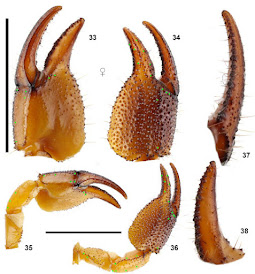Andres A. Ojanguren-Affilastro and co-workers have recently described a new species of Bothriurus Peters, 1861(Bothriuridae) from high-altitude habitats in north-central Andes of the Coquimbo Region in Chile.
Bothriurus mistral Ojanguren Affilastro, Mattoni, Alfaro & Pizarro-Araya, 2023
Abstract:
We describe Bothriurus mistral n. sp. (Scorpiones, Bothriuridae) from the Chilean north-central Andes of the Coquimbo Region. This is the highest elevational discovery for Bothriurus in the western slopes of the Andes. This species was collected in the Estero Derecho Private Protected Area and Natural Sanctuary as part of the First National Biodiversity Inventory of Chile of the Integrated System for Monitoring and Evaluation of Native Forest Ecosystems (SIMEF). Bothriurus mistral n. sp. is closely related to Bothriurus coriaceus Pocock, 1893, from the lowlands of central Chile. This integrative research includes a combination of traditional morphometrics and geometric morphometric analyses to support the taxonomic delimitation of the species.
Reference:
Ojanguren-Affilastro AA, Benitez HA, Iuri HA, Mattoni CI, Alfaro FM, Pizarro-Araya J. Description of Bothriurus mistral n. sp., the highest-dwelling Bothriurus from the western Andes (Scorpiones, Bothriuridae), using multiple morphometric approaches. PLoS One. 2023;18:e0281336. [Open Access]
Thanks to Gerard Dupre for sending me this article!





